Spin Physics at PHENIX †
Abstract
1. Introduction
2. Experiment
3. Results
3.1. Longitudinal Spin
3.1.1. Direct Photon
3.1.2. Pion
3.1.3. W Boson
3.2. Transverse Spin
3.2.1. Direct Photon
3.2.2. Open Heavy Flavor
3.2.3. Forward Charged Hadron and Meson
3.2.4. Forward Charged Hadron in
3.2.5. Far-Forward Neutron
4. Conclusions
Funding
Data Availability Statement
Conflicts of Interest
References
- Jaffe, R.; Manohar, A. The g1 problem: Deep inelastic electron scattering and the spin of the proton. Nucl. Phys. B 1990, 337, 509–546. [Google Scholar] [CrossRef]
- Adeva, B.; Akdogan, T.; Arik, E.; Arvidson, A.; Badelek, B.; Bardin, G.; Baum, G.; Berglund, P.; Betev, L.; Bird, I.G.; et al. Spin asymmetries A1 and structure functions g1 of the proton and the deuteron from polarized high energy muon scattering. Phys. Rev. D 1998, 58, 112001. [Google Scholar] [CrossRef]
- Abe, K.; Akagi, T.; Anthony, P.L.; Antonov, R.; Arnold, R.G.; Averett, T.; Band, H.R.; Bauer, J.M.; Borel, H.; Bosted, P.E.; et al. Measurements of the proton and deuteron spin structure functions g1 and g2. Phys. Rev. D 1998, 58, 112003. [Google Scholar] [CrossRef]
- Airapetian, A.; Akopov, N.; Akopov, Z.; Andrus, A.; Aschenauer, E.C.; Augustyniak, W.; Avakian, R.; Avetissian, A.; Avetissian, E.; Belostotski, S.; et al. Precise determination of the spin structure function g1 of the proton, deuteron, and neutron. Phys. Rev. D 2007, 75, 012007. [Google Scholar] [CrossRef]
- Prok, Y.; Bosted, P.; Kvaltine, N.; Adhikari, K.P.; Adikaram, D.; Aghasyan, M.; Amaryan, M.J.; Anderson, M.D.; Anefalos Pereira, S.; Avakian, H.; et al. Precision measurements of g1 of the proton and of the deuteron with 6 GeV electrons. Phys. Rev. C 2014, 90, 025212. [Google Scholar] [CrossRef]
- Adolph, C.; Akhunzyanov, R.; Alexeev, M.; Alexeev, G.; Amoroso, A.; Andrieux, V.; Anosov, V.; Austregesilo, A.; Azevedo, C.; Badełek, B.; et al. The spin structure function g1p of the proton and a test of the Bjorken sum rule. Phys. Lett. B 2016, 753, 18–28. [Google Scholar] [CrossRef]
- Alekseev, M.; Alexakhin, V.; Alexandrov, Y.; Alexeev, G.; Amoroso, A.; Austregesilo, A.; Badełek, B.; Balestra, F.; Barth, J.; Baum, G.; et al. Quark helicity distributions from longitudinal spin asymmetries in muon–proton and muon–deuteron scattering. Phys. Lett. B 2010, 693, 227–235. [Google Scholar] [CrossRef]
- Airapetian, A.; Akopov, N.; Akopov, Z.; Aschenauer, E.C.; Augustyniak, W.; Avakian, R.; Avetissian, A.; Belostotski, S.; Blok, H.P.; Borissov, A.; et al. Longitudinal double-spin asymmetries in semi-inclusive deep-inelastic scattering of electrons and positrons by protons and deuterons. Phys. Rev. D 2019, 99, 112001. [Google Scholar] [CrossRef]
- Adare, A.; Afanasiev, S.; Aidala, C.; Ajitanand, N.N.; Akiba, Y.; Al-Bataineh, H.; Alexander, J.; Aoki, K.; Aphecetche, L.; Asai, J.; et al. Inclusive cross section and double helicity asymmetry for π0 production in p + p collisions at = 62.4 GeV. Phys. Rev. D 2009, 79, 012003. [Google Scholar] [CrossRef]
- Adare, A.; Afanasiev, S.; Aidala, C.; Ajitanand, N.N.; Akiba, Y.; Al-Bataineh, H.; Alexander, J.; Aoki, K.; Aphecetche, L.; Asai, J.; et al. Gluon-Spin Contribution to the Proton Spin from the Double-Helicity Asymmetry in Inclusive π0 Production in Polarized p+p Collisions at = 200 GeV. Phys. Rev. Lett. 2009, 103, 012003. [Google Scholar] [CrossRef]
- Adare, A.; Afanasiev, S.; Aidala, C.; Ajitanand, N.N.; Akiba, Y.; Al-Bataineh, H.; Alexander, J.; Aoki, K.; Aphecetche, L.; Armendariz, R.; et al. Cross section and double helicity asymmetry for η mesons and their comparison to π0 production in p+p collisions at = 200 GeV. Phys. Rev. D 2011, 83, 032001. [Google Scholar] [CrossRef]
- Abelev, B.I.; Aggarwal, M.M.; Ahammed, Z.; Anderson, B.D.; Arkhipkin, D.; Averichev, G.S.; Bai, Y.; Balewski, J.; Barannikova, O.; Barnby, L.S.; et al. Longitudinal Double-Spin Asymmetry for Inclusive Jet Production in + Collisions at = 200 GeV. Phys. Rev. Lett. 2008, 100, 232003. [Google Scholar] [CrossRef] [PubMed]
- Abelev, B.I.; Aggarwal, M.M.; Ahammed, Z.; Alakhverdyants, A.V.; Anderson, B.D.; Arkhipkin, D.; Averichev, G.S.; Balewski, J.; Barannikova, O.; Barnby, L.S.; et al. Longitudinal double-spin asymmetry and cross section for inclusive neutral pion production at midrapidity in polarized proton collisions at = 200 GeV. Phys. Rev. D 2009, 80, 111108. [Google Scholar] [CrossRef]
- Adamczyk, L.; Agakishiev, G.; Aggarwal, M.M.; Ahammed, Z.; Alakhverdyants, A.V.; Alekseev, I.; Alford, J.; Anderson, B.D.; Anson, C.D.; Arkhipkin, D.; et al. Longitudinal and transverse spin asymmetries for inclusive jet production at mid-rapidity in polarized p+p collisions at = 200 GeV. Phys. Rev. D 2012, 86, 032006. [Google Scholar] [CrossRef]
- de Florian, D.; Sassot, R.; Stratmann, M.; Vogelsang, W. Evidence for Polarization of Gluons in the Proton. Phys. Rev. Lett. 2014, 113, 012001. [Google Scholar] [CrossRef]
- Nocera, E.R.; Ball, R.D.; Forte, S.; Ridolfi, G.; Rojo, J. A first unbiased global determination of polarized PDFs and their uncertainties. Nucl. Phys. B 2014, 887, 276–308. [Google Scholar] [CrossRef]
- Sivers, D. Single-spin production asymmetries from the hard scattering of pointlike constituents. Phys. Rev. D 1990, 41, 83–90. [Google Scholar] [CrossRef]
- Sivers, D. Hard-scattering scaling laws for single-spin production asymmetries. Phys. Rev. D 1991, 43, 261–263. [Google Scholar] [CrossRef]
- Collins, J. Fragmentation of transversely polarized quarks probed in transverse momentum distributions. Nucl. Phys. B 1993, 396, 161–182. [Google Scholar] [CrossRef]
- Airapetian, A.; Akopov, N.; Akopov, Z.; Amarian, M.; Andrus, A.; Aschenauer, E.C.; Augustyniak, W.; Avakian, R.; Avetissian, A.; Avetissian, E.; et al. Single-Spin Asymmetries in Semi-Inclusive Deep-Inelastic Scattering on a Transversely Polarized Hydrogen Target. Phys. Rev. Lett. 2005, 94, 012002. [Google Scholar] [CrossRef]
- Alexakhin, V.Y.; Alexandrov, Y.; Alexeev, G.D.; Amoroso, A.; Badełek, B.; Balestra, F.; Ball, J.; Baum, G.; Bedfer, Y.; Berglund, P.; et al. First Measurement of the Transverse Spin Asymmetries of the Deuteron in Semi-inclusive Deep Inelastic Scattering. Phys. Rev. Lett. 2005, 94, 202002. [Google Scholar] [CrossRef] [PubMed]
- Alekseev, M.; Alexakhin, V.; Alexandrov, Y.; Alexeev, G.; Amoroso, A.; Arbuzov, A.; Badełek, B.; Balestra, F.; Ball, J.; Barth, J.; et al. Collins and Sivers asymmetries for pions and kaons in muon–deuteron DIS. Phys. Lett. B 2009, 673, 127–135. [Google Scholar] [CrossRef]
- Airapetian, A.; Akopov, N.; Akopov, Z.; Aschenauer, E.C.; Augustyniak, W.; Avetissian, A.; Avetisyan, E.; Bacchetta, A.; Ball, B.; Bianchi, N.; et al. Observation of the Naive-T-Odd Sivers Effect in Deep-Inelastic Scattering. Phys. Rev. Lett. 2009, 103, 152002. [Google Scholar] [CrossRef] [PubMed]
- Ageev, E.; Alexakhin, V.; Alexandrov, Y.; Alexeev, G.; Alexeev, M.; Amoroso, A.; Badełek, B.; Balestra, F.; Ball, J.; Barth, J.; et al. A new measurement of the Collins and Sivers asymmetries on a transversely polarised deuteron target. Nucl. Phys. B 2007, 765, 31–70. [Google Scholar] [CrossRef][Green Version]
- Airapetian, A.; Akopov, N.; Akopov, Z.; Aschenauer, E.; Augustyniak, W.; Avakian, R.; Avetissian, A.; Avetisyan, E.; Bacchetta, A.; Belostotski, S.; et al. Effects of transversity in deep-inelastic scattering by polarized protons. Phys. Lett. B 2010, 693, 11–16. [Google Scholar] [CrossRef]
- Adolph, C.; Aghasyan, M.; Akhunzyanov, R.; Alexeev, M.; Alexeev, G.; Amoroso, A.; Andrieux, V.; Anfimov, N.; Anosov, V.; Augsten, K.; et al. Sivers asymmetry extracted in SIDIS at the hard scales of the Drell-Yan process at COMPASS. Phys. Lett. B 2017, 770, 138–145. [Google Scholar] [CrossRef]
- Seidl, R.; Grosse Perdekamp, M.; Ogawa, A.; Adachi, I.; Aihara, H.; Bahinipati, S.; Bakich, A.M.; Bartel, W.; Bitenc, U.; Bondar, A.; et al. Measurement of azimuthal asymmetries in inclusive production of hadron pairs in e+e− annihilation at = 10.58 GeV. Phys. Rev. D 2008, 78, 032011. [Google Scholar] [CrossRef]
- Efremov, A.; Teryaev, O. QCD asymmetry and polarized hadron structure function measurement. Phys. Lett. B 1985, 150, 383–386. [Google Scholar] [CrossRef]
- Qiu, J.; Sterman, G. Single transverse-spin asymmetries in hadronic pion production. Phys. Rev. D 1998, 59, 014004. [Google Scholar] [CrossRef]
- Ji, X. Gluon correlations in the transversely polarized nucleon. Phys. Lett. B 1992, 289, 137–142. [Google Scholar] [CrossRef]
- Kang, Z.B.; Qiu, J.W. Single transverse-spin asymmetry for D-meson production in semi-inclusive deep inelastic scattering. Phys. Rev. D 2008, 78, 034005. [Google Scholar] [CrossRef]
- Adcox, K.; Adler, S.; Aizama, M.; Ajitanand, N.; Akiba, Y.; Akikawa, H.; Alexander, J.; Al-Jamel, A.; Allen, M.; Alley, G.; et al. PHENIX detector overview. Nucl. Instrum. Methods Phys. Res. Sect. A 2003, 499, 469–479. [Google Scholar] [CrossRef]
- Zhou, Y.; Sato, N.; Melnitchouk, W. How well do we know the gluon polarization in the proton? Phys. Rev. D 2022, 105, 074022. [Google Scholar] [CrossRef]
- de Florian, D.; Forte, S.; Vogelsang, W. Higgs production at RHIC and the positivity of the gluon helicity distribution. Phys. Rev. D 2024, 109, 074007. [Google Scholar] [CrossRef]
- Abdulameer, N.J.; Acharya, U.; Adare, A.; Aidala, C.; Ajitanand, N.N.; Akiba, Y.; Akimoto, R.; Alfred, M.; Apadula, N.; Aramaki, Y.; et al. Measurement of Direct-Photon Cross Section and Double-Helicity Asymmetry at = 510 GeV in + Collisions. Phys. Rev. Lett. 2023, 130, 251901. [Google Scholar] [CrossRef]
- de Florian, D.; Lucero, G.A.; Sassot, R.; Stratmann, M.; Vogelsang, W. Monte Carlo sampling variant of the DSSV14 set of helicity parton densities. Phys. Rev. D 2019, 100, 114027. [Google Scholar] [CrossRef]
- Cocuzza, C.; Melnitchouk, W.; Metz, A.; Sato, N. Polarized antimatter in the proton from a global QCD analysis. Phys. Rev. D 2022, 106, L031502. [Google Scholar] [CrossRef]
- Acharya, U.; Adare, A.; Aidala, C.; Ajitanand, N.N.; Akiba, Y.; Akimoto, R.; Alfred, M.; Apadula, N.; Aramaki, Y.; Asano, H.; et al. Measurement of charged pion double spin asymmetries at midrapidity in longitudinally polarized p+p collisions at = 510 GeV. Phys. Rev. D 2020, 102, 032001. [Google Scholar] [CrossRef]
- Adare, A.; Aidala, C.; Ajitanand, N.N.; Akiba, Y.; Akimoto, R.; Al-Ta’ani, H.; Alexander, J.; Andrews, K.R.; Angerami, A.; Aoki, K.; et al. Charged-pion cross sections and double-helicity asymmetries in polarized p+p collisions at = 200 GeV. Phys. Rev. D 2015, 91, 032001. [Google Scholar] [CrossRef]
- Adare, A.; Aidala, C.; Ajitanand, N.N.; Akiba, Y.; Akimoto, R.; Alexander, J.; Alfred, M.; Aoki, K.; Apadula, N.; Aramaki, Y.; et al. Measurement of parity-violating spin asymmetries in W± production at midrapidity in longitudinally polarized p+p collisions. Phys. Rev. D 2016, 93, 051103. [Google Scholar] [CrossRef]
- Adare, A.; Aidala, C.; Ajitanand, N.N.; Akiba, Y.; Akimoto, R.; Alexander, J.; Alfred, M.; Aoki, K.; Apadula, N.; Aramaki, Y.; et al. Cross section and longitudinal single-spin asymmetry AL for forward W±→μ±ν production in polarized p+p collisions at = 510 GeV. Phys. Rev. D 2018, 98, 032007. [Google Scholar] [CrossRef]
- Adamczyk, L.; Adkins, J.K.; Agakishiev, G.; Aggarwal, M.M.; Ahammed, Z.; Alekseev, I.; Alford, J.; Anson, C.D.; Aparin, A.; Arkhipkin, D.; et al. Measurement of Longitudinal Spin Asymmetries for Weak Boson Production in Polarized Proton-Proton Collisions at RHIC. Phys. Rev. Lett. 2014, 113, 072301. [Google Scholar] [CrossRef] [PubMed]
- Adam, J.; Adamczyk, L.; Adams, J.R.; Adkins, J.K.; Agakishiev, G.; Aggarwal, M.M.; Ahammed, Z.; Alekseev, I.; Anderson, D.M.; Aoyama, R.; et al. Measurement of the longitudinal spin asymmetries for weak boson production in proton-proton collisions at = 51 GeV. Phys. Rev. D 2019, 99, 051102. [Google Scholar] [CrossRef]
- Acharya, U.A.; Aidala, C.; Akiba, Y.; Alfred, M.; Andrieux, V.; Apadula, N.; Asano, H.; Azmoun, B.; Babintsev, V.; Bandara, N.S.; et al. Probing Gluon Spin-Momentum Correlations in Transversely Polarized Protons through Midrapidity Isolated Direct Photons in p↑+p Collisions at = 200 GeV. Phys. Rev. Lett. 2021, 127, 162001. [Google Scholar] [CrossRef]
- Kanazawa, K.; Koike, Y.; Metz, A.; Pitonyak, D. Transverse single-spin asymmetries in p↑p→γX from quark-gluon-quark correlations in the proton. Phys. Rev. D 2015, 91, 014013. [Google Scholar] [CrossRef]
- Koike, Y.; Yoshida, S. Probing the three-gluon correlation functions by the single spin asymmetry in p↑p→DX. Phys. Rev. D 2011, 84, 014026. [Google Scholar] [CrossRef]
- Adams, D.L.; Achurin, N.; Belikov, N.I.; Bravar, A.; Bystricky, J.; Corcoran, M.D.; Cossairt, J.D.; Cranshaw, J.; Derevschikov, A.A.; En’yo, H.; et al. Measurement of single spin asymmetry for direct photon production in pp collisions at 200-GeV/c. Phys. Lett. B 1995, 345, 569–575. [Google Scholar] [CrossRef]
- Abdulameer, N.J.; Acharya, U.; Aidala, C.; Akiba, Y.; Alfred, M.; Andrieux, V.; Apadula, N.; Asano, H.; Azmoun, B.; Babintsev, V.; et al. Improving constraints on gluon spin-momentum correlations in transversely polarized protons via midrapidity open-heavy-flavor electrons in p↑+p collisions at = 200 GeV. Phys. Rev. D 2023, 107, 052012. [Google Scholar] [CrossRef]
- Kang, Z.B.; Qiu, J.W.; Vogelsang, W.; Yuan, F. Accessing trigluon correlations in the nucleon via the single spin asymmetry in open charm production. Phys. Rev. D 2008, 78, 114013. [Google Scholar] [CrossRef]
- Abdulameer, N.J.; Acharya, U.; Aidala, C.; Akiba, Y.; Alfred, M.; Andrieux, V.; Apadula, N.; Asano, H.; Azmoun, B.; Babintsev, V.; et al. Transverse single-spin asymmetry of charged hadrons at forward and backward rapidity in polarized p+p, p+Al, and p+Au collisions at = 200 GeV. Phys. Rev. D 2023, 108, 072016. [Google Scholar] [CrossRef]
- Kanazawa, K.; Koike, Y.; Metz, A.; Pitonyak, D. Towards an explanation of transverse single-spin asymmetries in proton-proton collisions: The role of fragmentation in collinear factorization. Phys. Rev. D 2014, 89, 111501. [Google Scholar] [CrossRef]
- Gamberg, L.; Malda, M.; Miller, J.A.; Pitonyak, D.; Prokudin, A.; Sato, N. Updated QCD global analysis of single transverse-spin asymmetries: Extracting , and the role of the Soffer bound and lattice QCD. Phys. Rev. D 2022, 106, 034014. [Google Scholar] [CrossRef]
- Aidala, C.; Akiba, Y.; Alfred, M.; Andrieux, V.; Apadula, N.; Asano, H.; Azmoun, B.; Babintsev, V.; Bandara, N.S.; Barish, K.N.; et al. Nuclear Dependence of the Transverse Single-Spin Asymmetry in the Production of Charged Hadrons at Forward Rapidity in Polarized p + p, p + Al, and p + Au Collisions at = 200 GeV. Phys. Rev. Lett. 2019, 123, 122001. [Google Scholar] [CrossRef] [PubMed]
- Miller, M.L.; Reygers, K.; Sanders, S.J.; Steinberg, P. Glauber Modeling in High-Energy Nuclear Collisions. Annu. Rev. Nucl. Part. Sci. 2007, 57, 205–243. [Google Scholar] [CrossRef]
- Benić, S.; Hatta, Y. Single spin asymmetry in forward pA collisions: Phenomenology at RHIC. Phys. Rev. D 2019, 99, 094012. [Google Scholar] [CrossRef]
- Gao, J.H.; Liang, Z.T.; Wang, X.N. Nuclear dependence of azimuthal asymmetry in semi-inclusive deep inelastic scattering. Phys. Rev. C 2010, 81, 065211. [Google Scholar] [CrossRef]
- Aidala, C.; Akiba, Y.; Alfred, M.; Andrieux, V.; Aoki, K.; Apadula, N.; Asano, H.; Ayuso, C.; Azmoun, B.; Babintsev, V.; et al. Nuclear Dependence of the Transverse-Single-Spin Asymmetry for Forward Neutron Production in Polarized p + A Collisions at = 200 GeV. Phys. Rev. Lett. 2018, 120, 022001. [Google Scholar] [CrossRef]
- Kopeliovich, B.Z.; Potashnikova, I.K.; Schmidt, I.; Soffer, J. Single transverse spin asymmetry of forward neutrons. Phys. Rev. D 2011, 84, 114012. [Google Scholar] [CrossRef]
- Mitsuka, G. Recently measured large AN for forward neutrons in p↑A collisions at = 200 GeV explained through simulations of ultraperipheral collisions and hadronic interactions. Phys. Rev. C 2017, 95, 044908. [Google Scholar] [CrossRef]
- Acharya, U.A.; Aidala, C.; Akiba, Y.; Alfred, M.; Andrieux, V.; Apadula, N.; Asano, H.; Azmoun, B.; Babintsev, V.; Bandara, N.S.; et al. Transverse single spin asymmetries of forward neutrons in p + p, p + Al, and p + Au collisions at = 200 GeV as a function of transverse and longitudinal momenta. Phys. Rev. D 2022, 105, 032004. [Google Scholar] [CrossRef]
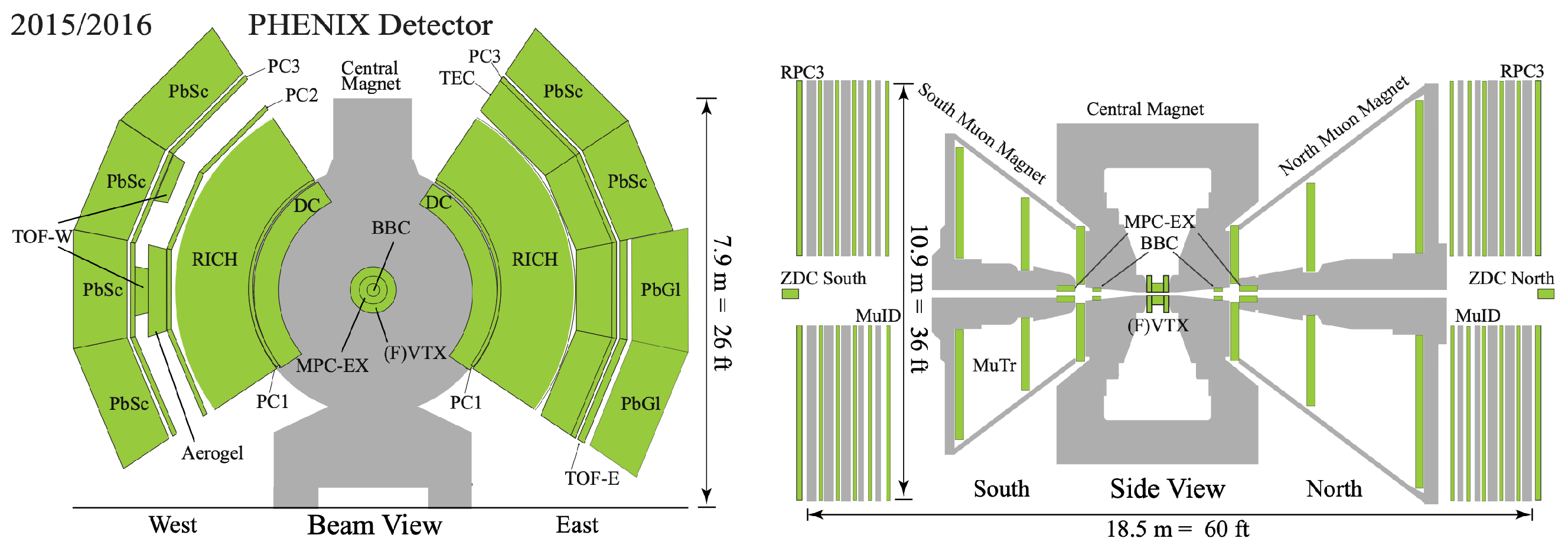
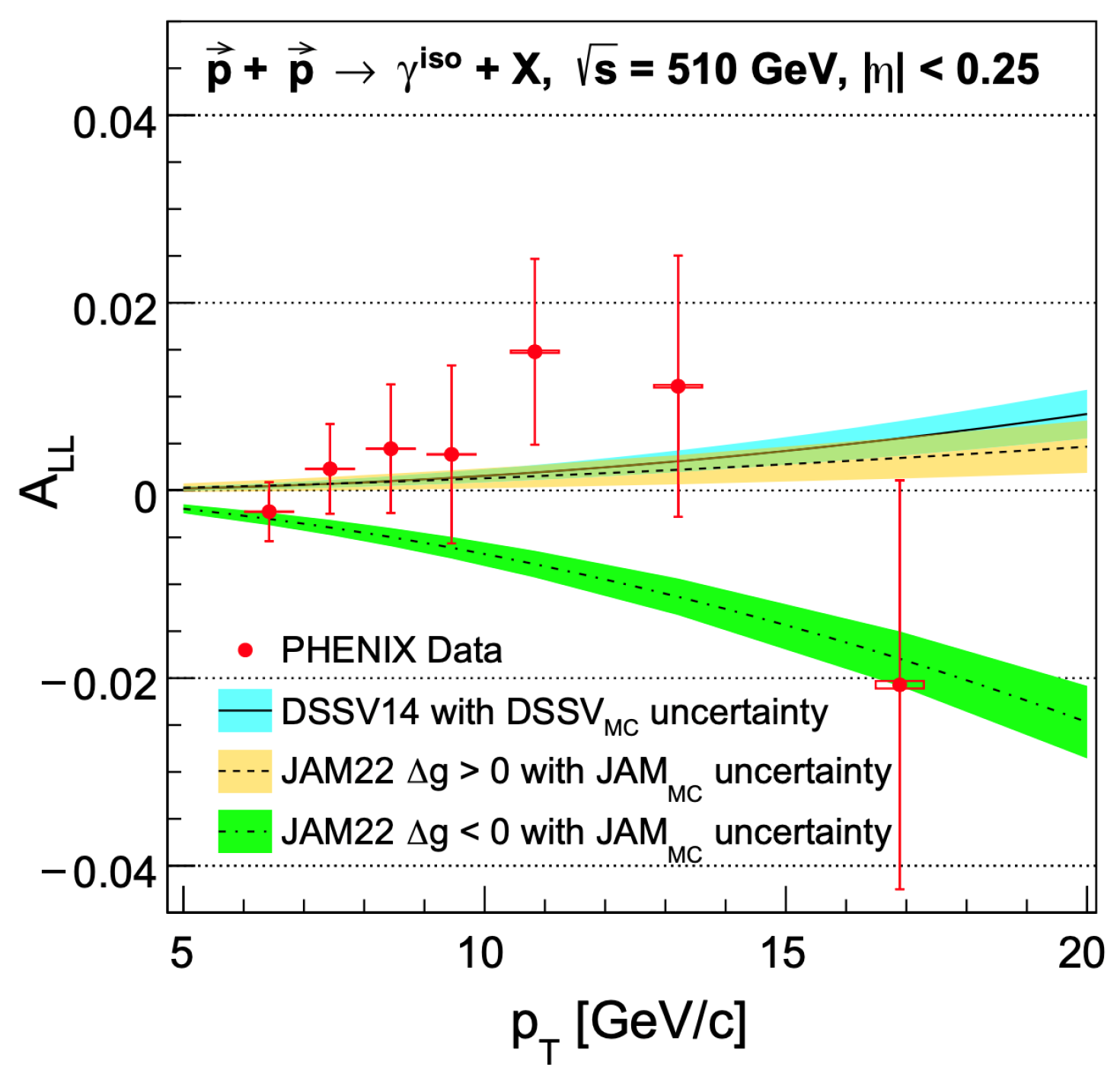
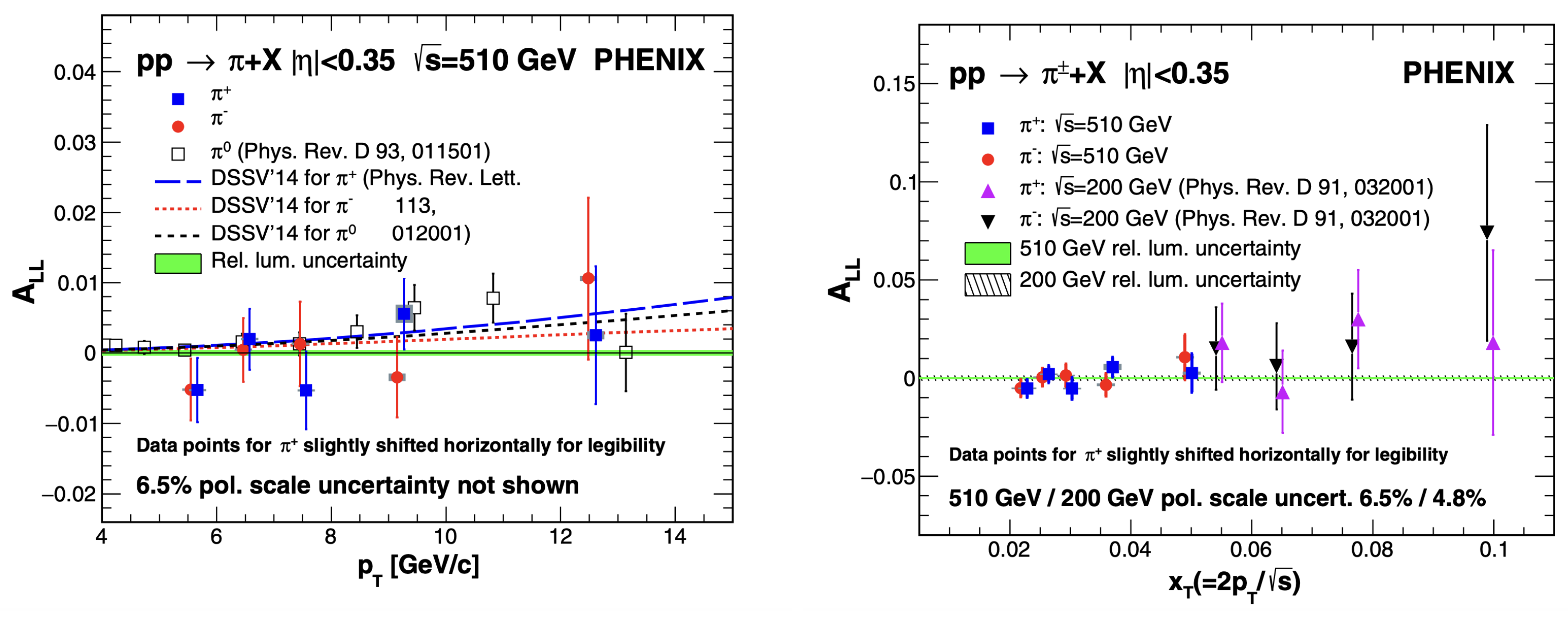

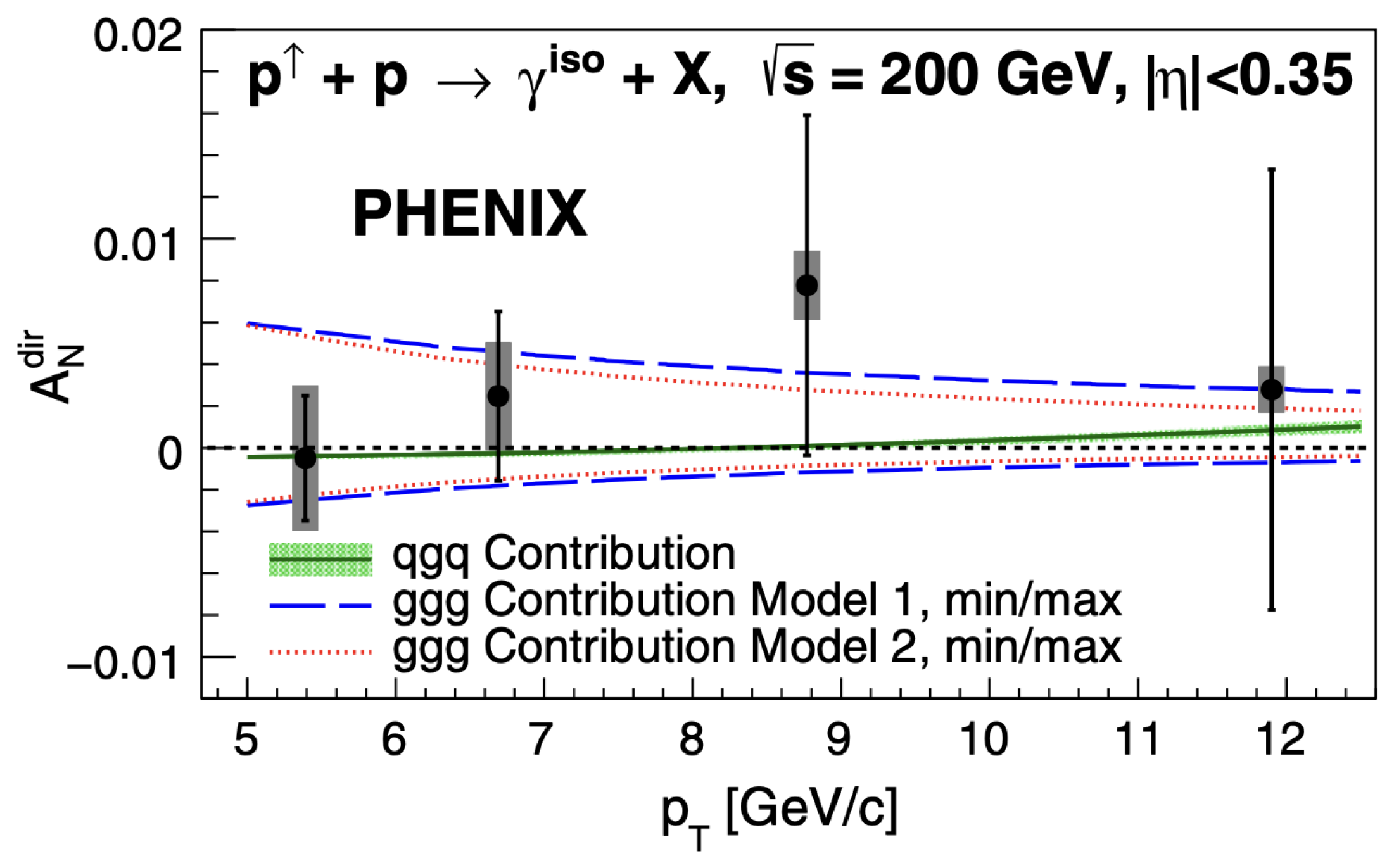
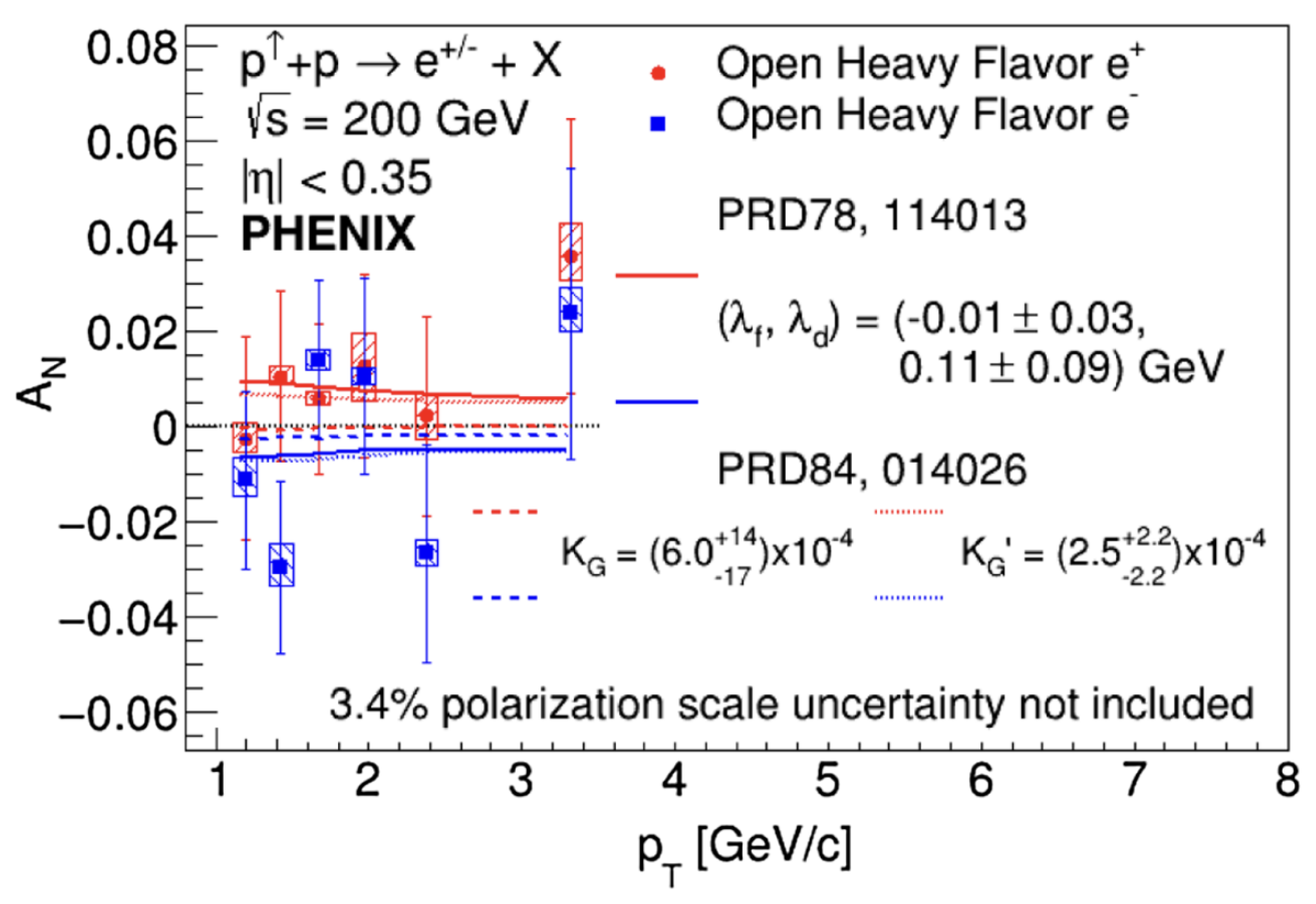




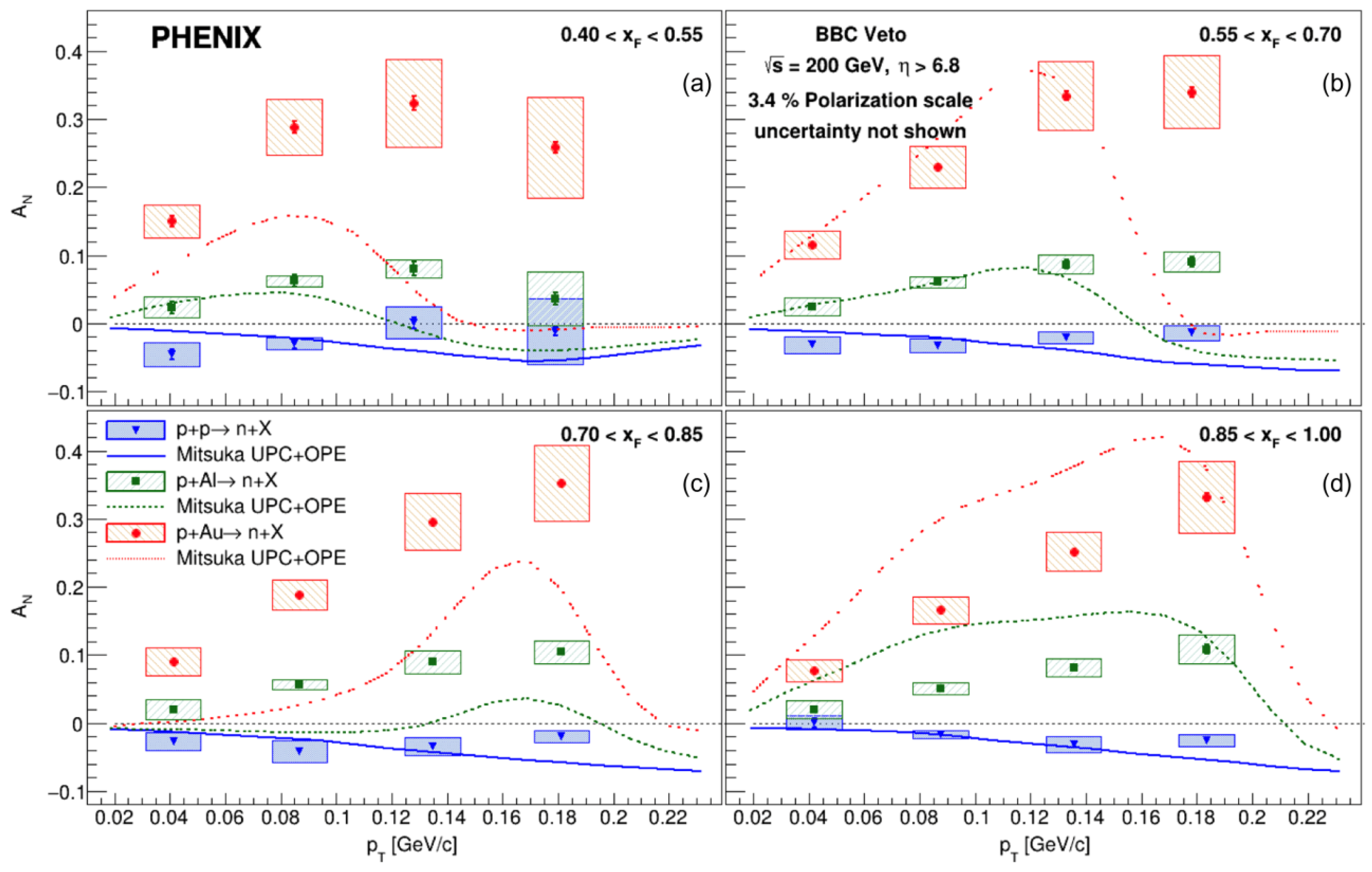
| Year | System | Polarization | Recorded | |
|---|---|---|---|---|
| Direction | Luminosity [] | |||
| 2006 | p + p | transverse | 0.02 | |
| 62.4 | longitudinal | 0.08 | ||
| 200 | transverse | 2.7 | ||
| longitudinal | 7.5 | |||
| 2008 | p + p | 200 | transverse | 5.2 |
| 2009 | p + p | 200 | longitudinal | 16 |
| 500 | 14 | |||
| 2011 | p + p | 500 | longitudinal | 18 |
| 2012 | p + p | 200 | transverse | 9.7 |
| 510 | longitudinal | 32 | ||
| 2013 | p + p | 510 | longitudinal | 155 |
| p + p | 200 | transverse | 60 | |
| 2015 | p + Au | 1.27 | ||
| p + Al | 3.97 |
Disclaimer/Publisher’s Note: The statements, opinions and data contained in all publications are solely those of the individual author(s) and contributor(s) and not of MDPI and/or the editor(s). MDPI and/or the editor(s) disclaim responsibility for any injury to people or property resulting from any ideas, methods, instructions or products referred to in the content. |
© 2025 by the author. Licensee MDPI, Basel, Switzerland. This article is an open access article distributed under the terms and conditions of the Creative Commons Attribution (CC BY) license (https://creativecommons.org/licenses/by/4.0/).
Share and Cite
Loomis, D., on behalf of the PHENIX Collaboration. Spin Physics at PHENIX. Particles 2025, 8, 14. https://doi.org/10.3390/particles8010014
Loomis D on behalf of the PHENIX Collaboration. Spin Physics at PHENIX. Particles. 2025; 8(1):14. https://doi.org/10.3390/particles8010014
Chicago/Turabian StyleLoomis, Devon on behalf of the PHENIX Collaboration. 2025. "Spin Physics at PHENIX" Particles 8, no. 1: 14. https://doi.org/10.3390/particles8010014
APA StyleLoomis, D., on behalf of the PHENIX Collaboration. (2025). Spin Physics at PHENIX. Particles, 8(1), 14. https://doi.org/10.3390/particles8010014








